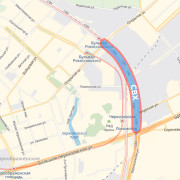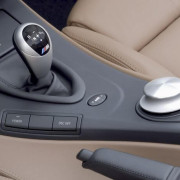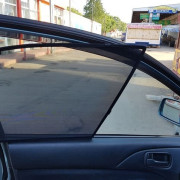Vw e-up! review
Содержание:
- Still be fun to drive
- VW e-up! comfort & practicality
- Общие технические характеристики
- Basic Configuration¶
- Using both Connections¶
- Прототипы
- How much does it cost to charge a VW e-up!?
- Другие варианты
- How long does it take to charge a VW e-up!?
- Practical interior remains largely unchanged
- Транспорт для города
- VW e-up! interior review
- VW e-up! range & charging
- VW e-up! performance review
- VW e-up! comfort review
- VW e-up! storage review
- The VW e-up! on the road
- Charging a VW e-up! at home
- VW e-up! tech & specifications
Still be fun to drive
Though the previous model of e-Up had its flaws, it was good fun to drive. The instant response and great low-down power endowed by the electric motor meant it was easy to extract the fun factor from and the latest version merely adds to that.
Its primary downside is that if fun in a tiny VW is your primary objective, then be aware that the 115hp Up GTI weighs in some £4,000 less expensive after the government’s £3,000 Plug-in Car Grant has been deducted.
However, for most people that won’t be the main reason for purchasing the electric Up. Is it so much better than its SEAT and Skoda cousins to justify the elevated price tag or does it make more sense to plump for a slightly larger battery electric (BEV) small car such as the Honda e, MINI Electric Hatch or overhauled Renault Zoe?
Continue reading Parkers’ expert Volkswagen e-Up review to find out.
VW e-up! comfort & practicality

It’s a good job a large swathe of coloured plastic can be found on the e-up!’s dashboard, otherwise the interior would seem rather drab. Instead, the little VW manages to be youthful but sensible. There is a small entertainment screen/system, but the driver is expected to download the ‘Maps + More’ app to their smartphone for full navigation, music and trip computer information. This does at least mean that it will stay up to date far more than many an in-built sat-nav system. The trailing cable when keeping the phone charged up is a little sloppy aesthetically, however. Otherwise, switchgear and interior materials are typically VW – excellent. For its class, the build quality feels very good, and the e-up! can feel a larger car than it really is.
The rest of the interior is relatively practical. The boxy shape means that there is a useful boot, and the rear seats can cope with a couple of adults or child seats. You could seat four for a trip to the supermarket for example, though packing the boot might take a bit of care.
Overall, for a city car, the e-up! is a useable daily driver even for those trips that have more than two people, which can’t be said of all its rivals.
Общие технические характеристики
Главная особенность электромобиля Volkswagen e-Up — электрический мотор мощностью 60 кВт, что в эквиваленте составляет 82 лошадиные силы.
Питание силового узла
Обеспечивает литий-ионная батарея мощностью 18,7 кВ. На одном заряде аккумулятора машина преодолевает 150 километров в экономичном режиме.
Максимальный момент вращения электрического мотора Volkswagen e-Up — 210 Н*м. Проведенные тесты и опыт эксплуатации показали, что машина разгоняется до «сотни» с места за 14 секунд. Верхний предел скорости — 135 км/час.
В Volkswagen e-Up предусмотрена комбинированный узел подзаряда, обеспечивающий питание АКБ от разных источников питания (переменного или постоянного). Благодаря этому, допускается заряд автомобиля на любой станции, вне зависимости от скорости подзаряда и используемого источника питания.

Производитель автомобиля уверяет, что с помощью станции быстрого заряда (при отсутствии полного заряда АКБ) возможно восстановление источника питания на 80% за 35-40 минут времени.

Но пока не ясно, какие устройства и сети требуются для столь скоростной зарядки аккумуляторной батареи.
Система электрификации Volkswagen e-Up компактна, что гарантирует дополнительное пространство под капотом.
Вес и габаритные размеры
Volkswagen e-Up компактен и весит 1,185 тонны. Габариты — длина (3,199 метра), ширина (2,19 метра).
Несмотря на размеры, внутри пассажирам комфортно. Так, в машине смело помещается три взрослых человека и ребенок.
Разрешается пять человек, но комфортабельность пострадает. Клиренс машины низковат для местных дорог — 132 мм.

Оптика и диски
Внешне стоит отметить светодиодные фары, расположенные на бампере спереди, и аэродинамический отвес. Колесные диски, как уже упоминалось, имеют размер 165/65 R15.
Ходовая тормоза и рулевое управление.
Что касается ходовой системы и рулевого управления, то здесь электромобиль повторяет бензиновую версию.
Спереди установлены PQ12 и стойки McPherson, а сзади — скручивающаяся балка.

Для облегчения вращения рулевого колеса установлен электромеханический усилитель.
Тормозная система — дисковая спереди (вентилируемая) и барабанная сзади.

Салон
Отдельно стоит отметить отделку салона. Некоторые элементы интерьера покрыты хромом. На сидениях натянут износостойкий материал серого цвета.


На сенсорной панели Volkswagen e-Up отражается информация, которая необходима водителю — уровень заряда, километраж, месторасположение ближайших заправок и так далее.

Стартовая цена на Volkswagen e-Up в Великобритании — от 19 тысяч фунтов стерлингов. В эту стоимость входит цена на АКБ.
Сегодня в Германии автомобиль стоит 29-30 тысяч евро, в Латвии — от 26 тысяч евро, в России и Украине цены приблизительно те же (28-30 тысяч евро).
Общие технические характеристики:
- Мощность электрического мотора — 60 кВт;
- Питание — Li-Ion аккумулятор;
- Среднее время на подзаряд аккумулятора — 5 часов. Применение станций быстрого подзаряда гарантирует восстановление АКБ на 80% за 35-40 минут;
- Верхний предел скорости — 135 км/час;
- Разгон до «сотни» — 14 секунд;
- Дальность пробега на одном заряде — 150 км.
Автомобиль компактен, нет претензий к комплектации, электрический мотор надежен и неприхотлив.
Проблема в том, что в странах СНГ электрические заправки не сильно распространены, а многие еще только в проекте, поэтому покупка Volkswagen e-Up приведет только к проблемам.
Что касается Европы, то там этот автомобиль давно пришелся по душе ценителям экологически чистого вида транспорта. При наличии большого числа электрических заправок поездки на такой машине — одно удовольствие.
Покупают Volkswagen e-Up и в странах СНГ, но в этом случае далеко от дома отъезжать не стоит, ведь запаса хода хватает только на 130-150 километров.
Basic Configuration¶
After selecting the VW e-Up vehicle module, the corresponding settings have to be made in the web interface via the “VW e-Up” menu under “Features”:
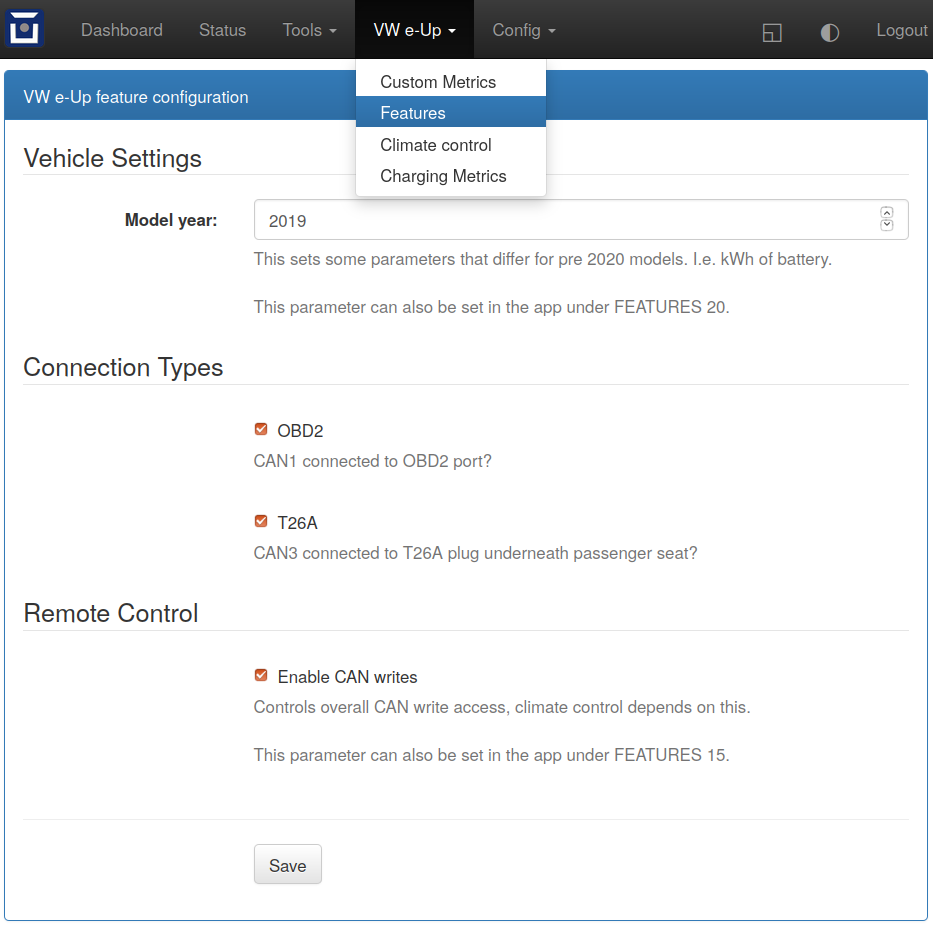
By default, both connections are activated.
For more details on the two connection types, please see the corresponding projects:
The initial code is shamelessly copied from the original projects for the Comfort CAN by Chris van der Meijden and for the OBD2 port by SokoFromNZ.
List of (possible) metrics via OBD2: https://www.goingelectric.de/wiki/Liste-der-OBD2-Codes/
If OBD is selected, a sample page with some charging metrics is shown in the web interface:

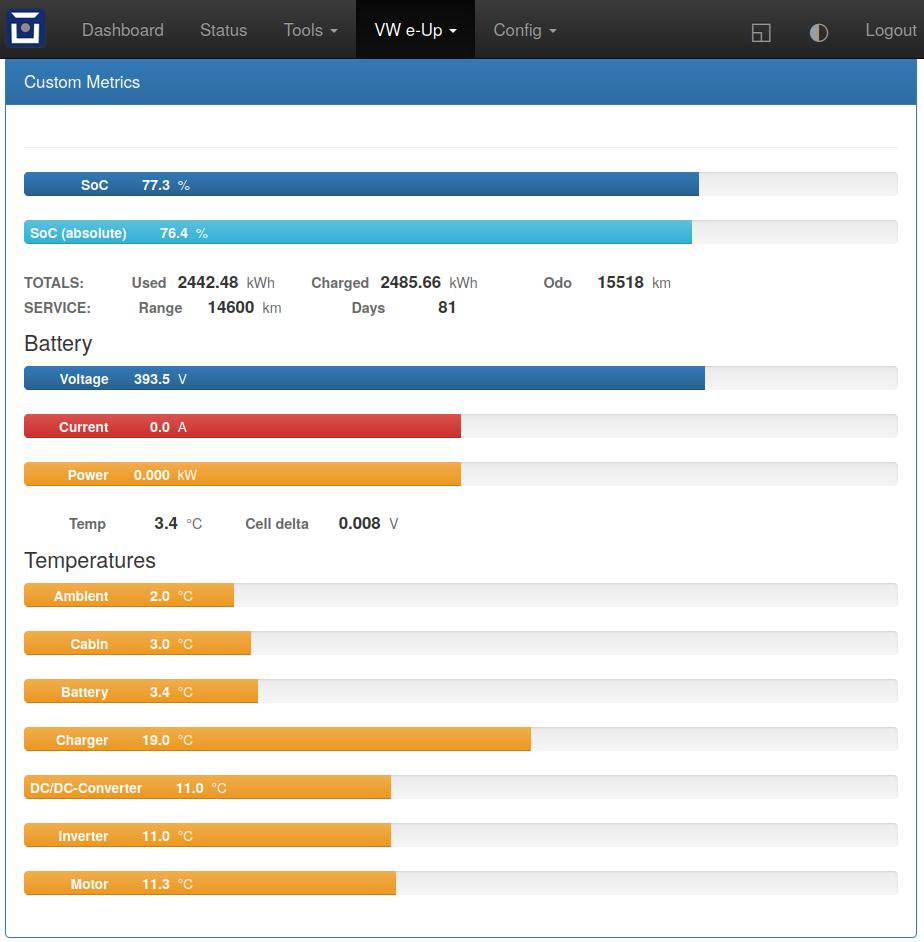
Beware: obviously, these values have great uncertainties (in my car, the DC output voltage of the charger is always lower than the voltage of the battery…)
But e.g. the internal energy counters are very informative 🙂
Using both Connections¶
This document shows two options to use both connections:
- Variant 1 connects to the Comfort CAN using the OCU T26A connector.
- Variant 2 connects to the Comfort CAN by tapping the Comfort CAN cables.
Both variants allow keeping the OCU in place. If you intend to replace the
OCU by the OVMS and reuse the OCU antennas for the OVMS, variant 1 will
probably be the better choice.
Variant 1
Connecting to the Comfort CAN using the OCU T26A connector
You need to establish a connection between the OBD2 and the OCU ports.
If installing the OVMS near the OBD2 port, you need to make a cable to
connect to the T26A plug (or tap into the T26A cable there). If
installing the OVMS replacing the OCU, you need to connect the OBD2
CAN bus from there.
An adapter cable has to be made with the following connections:
The cable used between the OBD plug and the DB9-F plug needs to be
twisted to avoid transmission problems. A good cable to use here is a
CAT-5 or CAT-6 double shielded network cable. Be sure to not only
connect CAN hi and CAN lo, but also connect ground.
| T26 | OBD | DB9-F | Signal |
|---|---|---|---|
| 26 | 4 | 3 | Chassis / Power GND |
| . | 14 | 2 | can1 L (OBD2 CAN Low) |
| . | 6 | 7 | can1 H (OBD2 CAN High) |
| . | . | 4 | can2 L (not used) |
| . | . | 5 | can2 H (not used) |
| 2 | . | 6 | can3 L (Comfort-CAN Low) |
| 14 | . | 8 | can3 H (Comfort-CAN High) |
| 1 | . | 9 | +12V Vehicle Power |
Important note: the VW T26a pin numbering scheme does not follow
the IT standard (zig zag) but instead has pins 1-13 left to right on
the top and 14-26 left to right on the bottom row. See image above.
Прототипы
У разных прототипов есть свои варианты, обозначающие их особенности:
- Volkswagen Up! : обычные тепловые, от 60 до 75 л.с.
-
Volkswagen e-up! : полностью электрический, 60 кВт — 210 Н · м
- Volkswagen Eco Up! : двигатель на природном газе, 68 л.с.
- Volkswagen GT Up! : тип GT , двигатель не менее 100 л.с.
- Volkswagen Cross Up! : пятидверный поднятый, классический термо
- Volkswagen Up! Azzurra Sailing Team: вариант с откидным верхом
- Volkswagen Buggy Up! : вариант глючного типа
- Volkswagen X Up! : вариант Cross Up! (Оборудован ящиком на крыше с двумя мощными проекторами) пять дверей
- Volkswagen Winter Up! : вариант Cross Up! (Оборудован двумя сноубордами на крыше и боковыми щитками) пять дверей
- Volkswagen Swiss Up! : вариант (Оборудован внутри, с карманом, специально предназначенным для хранения швейцарского армейского ножа) пять дверей
- Volkswagen Cargo Up! : вариант Cross Up! (Оборудован перегородкой из оргстекла за единственным сиденьем автомобиля) три двери
How much does it cost to charge a VW e-up!?
The table shown below shows estimates of the cost to charge the VW e-up!’s 32.3 kWh battery at home (on a domestic tariff) or using a rapid charge point. Cost estimates are dependent on the charge remaining, usable battery capacity, and age of battery pack. Cost per mile is calculated using an estimate of real-world range.
| Type | Cost/kWh | Cost to charge | Cost per mile |
|---|
Based on these figures, the VW e-up!’s fuel costs are 3-6 p/mile based on real-world energy usage, the cost depending on the type of charging. In general, home charging provides the cheapest per mile cost and public rapid charging tends to be around double the cost. These fuel costs compare favourably with 12-15 p/mile for conventional petrol and diesel cars.
To find the cost and times to charge an EV on a public charge point, Zap-Map’s Public Charging Calculator calculates charging costs for any new or used plug-in vehicle. The results can be personalised for different electricity costs and the level of charge required.
Другие варианты
Cross Up!
The Up! в Cross Up финише! доступен с двумя разными движками (эссенции для обоих как для всех Up!)
1-литровый двигатель мощностью 75 л.с., потребляющий 4,60 л на 100 км, и 1-литровый TSI мощностью 90 л.с., потребляющий 4,80 л на 100 км. К результатам следует относиться с недоверием, например, модель, оснащенная 1,0 л мощностью 75 л.с., потребляет в среднем почти 5,8 л / 100 в соответствии с фактическими средними показателями пользователей на сайте спритмонитора.
Эти двигатели доступны только на бензине.
e-Up!
| Volkswagen e-up! | |
| Также называемый | Сиденье Mii Electric Škoda Citigo-e iV |
|---|---|
| отметка | Фольксваген |
| Годы производства | — Этап 1: — Этап 2.1: — Этап 2.2: — |
| Класс | |
| Сборочный завод (а) | Братислава , Словацкая Республика |
| Двигатель и трансмиссия | |
| Энергия | Электричество |
| Мотор (ы) | Электрический |
| Положение двигателя | Перед |
| Максимальная мощность | От 5 до 83 л.с. (от 4 до 13 кВт) л.с. (32,3 кВт ) |
| Максимальный крутящий момент | От 33 до 57 Нм |
| Передача инфекции | Тяга |
| Коробка передач | Автоматический |
| Вес и производительность | |
| Вес без патронов | 1031 кг |
| Максимальная скорость | От 130 до 160 км / ч |
| Ускорение | От 0 до 100 км / ч за 13,2 — 11,9 с |
| Автономия | 246 км |
| Выбросы CO 2 | 00 г / км |
| Шасси — Кузов | |
| Тело (а) | 3 и 5 двери |
| Габаритные размеры | |
| Длина | 3540 мм |
| Ширина | 1641 мм |
| Высота | 1489 мм |
| Колесная база | 2420 мм |
| Пути Передняя / задняя | 1428 мм / 1424 мм |
| Объем багажника | От 130 до 830 дм 3 |
Volkswagen е вверх! это электрическая (а не гибридная) версия Volkswagen Up! выпущен в 2013 году . По конструкции он похож на тепловизионную модель, имеет 4 сиденья и производится в Словацкой Республике в Братиславе .
В году он возвращается с новой батареей на 32,3 кВтч.
Вверх! Аудио удары
Вверх! Аудио удары
The Up! Beats audio — результат некоторых незначительных изменений отделки High Up! : Аудиосистема мощностью 300 Вт и логотип Beats audio на задних стеклах. Сабвуфер также размещается в багажнике вместо запаски. Эта ограниченная серия из 800 экземпляров отличается красными штрихами в центре легкосплавных колесных дисков (15 дюймов), красными колпаками зеркал и серо-красной окантовкой на боковых порогах. Панель приборов окрашена в белый цвет и украшена визуальными элементами, вдохновленными Beats, что придает этой ограниченной серии молодую и динамичную атмосферу.
Ускорься!
| Volkswagen Speed Up! | |
| отметка | Фольксваген |
|---|---|
| Годы производства | С 2015 г. |
| Класс | Спортивное |
| Двигатель и трансмиссия | |
| Мотор (ы) | 1.0 TSI 105 л.с. |
| Положение двигателя | Передняя поперечная |
| Максимальная мощность | 105 л.с. |
| Вес и производительность | |
| Максимальная скорость | 182 км / ч |
| Ускорение | От 0 до 100 км / ч за 9,3 с |
Спортивная версия немецкого городского автомобиля, представленная в 2011 году под названием GT Up! Concept, была выпущена в Бразилии в 2015 году .
вверх! GTi
| Volkswagen up! GTi | |
| отметка | Фольксваген |
|---|---|
| Годы производства | С 2018 г. |
| Класс | Спортивное |
| Двигатель и трансмиссия | |
| Энергия | Бензин |
| Мотор (ы) | 3-х цилиндровый 1.0 TSI 115 л.с. |
| Положение двигателя | Передняя поперечная |
| Максимальная мощность | 115 л.с. |
| Максимальный крутящий момент | 200 Нм |
| Передача инфекции | Тяга |
| Коробка передач | 6-ступенчатая механика |
| Вес и производительность | |
| Вес без патронов | От 947 до 1020 кг |
| Максимальная скорость | 196 км / ч |
| Ускорение | От 0 до 100 км / ч за 8,8 с |
| Смешанное потребление | 4,8 л / 100 км |
| Выбросы CO 2 | 110 г / км |
| Шасси — Кузов | |
| Тело (а) | 3-дверный седан |
| Габаритные размеры | |
| Длина | 3700 мм |
| Ширина | 1,630 мм |
| Колесная база | 2420 мм |
| Хронология моделей | |
Volkswagen up! доступен в спортивной версии GTi на 2018 год . Его двигатель выдает 115 л.с.
How long does it take to charge a VW e-up!?

The following table shows approximate time to charge a VW e-up!. Times are for a 100% charge for all but rapid charging, which is quoted for 0-80% as most rapid chargers reduce or cut power well before 100% charge to protect the battery and maximise efficiency.
Note that the times shown are only a guide, as very rarely will an EV need to be fully charged from 0%. Other factors that might vary the charging time include ambient temperature, in-vehicle energy loads, any upper and lower charge restrictions to extend battery life and protect against potential damage, and charging rates slowing down as the maximum charge is reached.
| Rapid 50kW | Fast 22kW | Fast 7kW | Slow 3kW |
|---|---|---|---|
| 45 mins 0-80% | 4.5 hours 0-100% | 4.5 hours 0-100% | 11 hours 0-100% |
The VW e-up! is fitted with a 7.2 kW on-board charger for AC charging, as well as being able to rapid charge at up to 40 kW DC. This means that even when connected to a fast charger with a rated output above 7.2 kW, the VW e-up! will only be able to charge at 7.2 kW.
Use Zap-Map’s Home Charging Calculator to estimate charging times for a VW e-up!. The level of battery charge, connector speed, and on-board charger options can be tailored to your requirements for more accurate results.
Practical interior remains largely unchanged
The e-Up retains the same bodywork and interior fittings as the standard Up city car. This is, by-and-large, a good thing – even eight years on from its debut, it remains one of the very best city car interiors. Usefully, tts boxy body allows for genuine space inside for four adults, while the deep boot gives a surprising amount of room for luggage, although you’ll have to store suitcases vertically.
As befitting its lofty price tag, the e-Up’s specification levels are high incorporating dual-zone climate control, heated seats and a bespoke smartphone dock, plus a companion ‘Maps&More’ app. Through this, owners can not only operate the sat-nav and infotainment, but remotely check state of charge or pre-condition the air-conditioning, cooling the car down or heating it up as desired while it’s still charging.
Транспорт для города
Автомобиль с самого начала позиционировался как транспорт для города.

Его отличия — компактность, малый объем мотора, экономичность и надежность в эксплуатации.
В России машина появилась спустя год, на Московском автосалоне в 2012-м. Производители отмечают, что новая модель взяла лучшее от моделей ?koda Citigo и SEAT Mii.
Как упоминалось, автомобиль впервые увидел мир в 2011 году, а еще через 6 месяцев появился пятидверный вариант.
Но на этом разработчики Фольксваген не остановились, выпустив в марте 2013 года новую модель, построенную на базе предшественника — Volkswagen e-Up. Теперь новое авто оборудовалось не бензиновым (дизельным) мотором как прошлые «собратья», а электрическим силовым агрегатом.
Впервые новая машина представлена во Франкфурте. С тех пор и началась эпоха новых электромобилей Фольксваген.
VW e-up! interior review
Unfortunately, the same praise couldn’t be associated with the e-up!’s interior design. Here, the seats are lined with a basic ‘Fusion’ cloth upholstery, and the bear-all-plastic dashboard with a ‘Black Cube’ finish.
Looking around the interior cabin, there’s a sense of cheapness that creeps in and shows where the automaker has attempted to keep the car’s manufacturing costs down to a minimum.

It’s even more evident when you look at the car’s inner door frames, which have a mixture of plastic and an inherent lack of fabric, which leads to the exterior metal finish staying on show – pick the ‘Tornado Red’ colour option for the exterior of the vehicle, for example, and the non-metallic paint will also reside within the cabin.
Elsewhere, the infotainment system is a non-touch based 5″ colour display that resides at the centre of the dashboard. Android Auto and Apple CarPlay, aren’t supported. Some consumers might feel an advanced system would have spruced up the car’s technology. Alas, you’ll have to reside to physical buttons and knobs, instead.
1 of 5
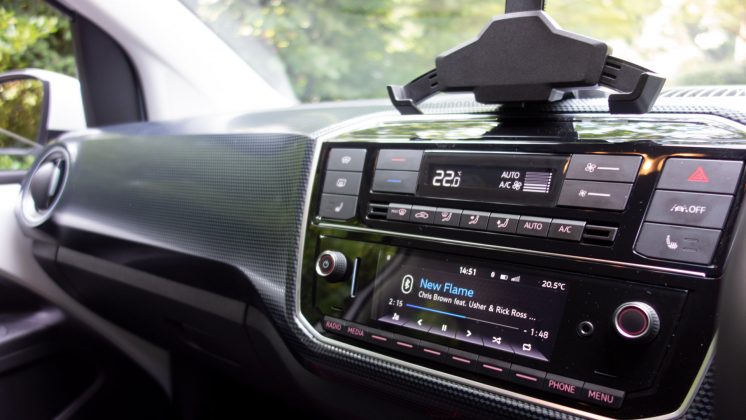
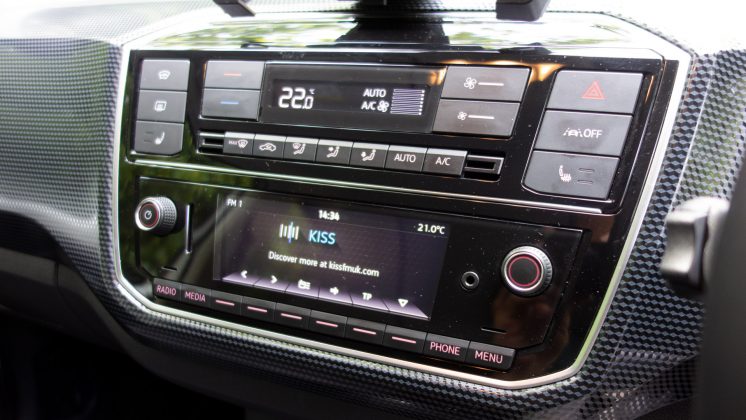
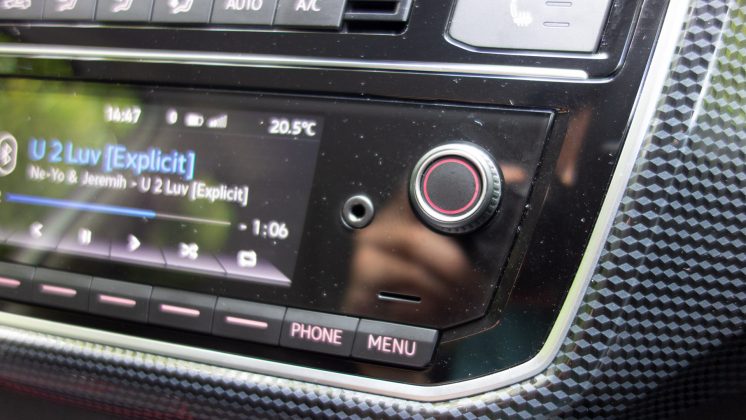
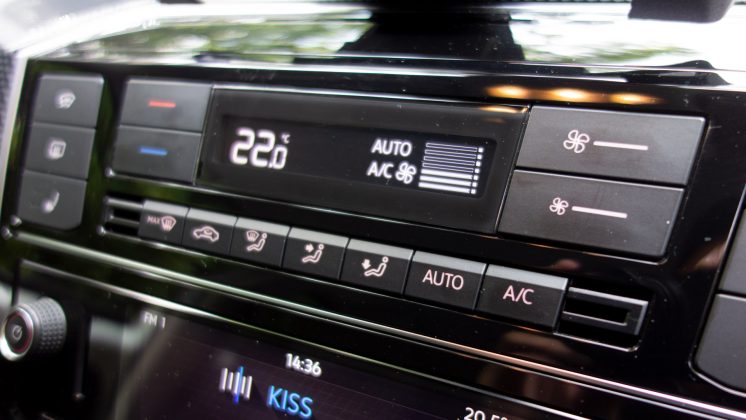
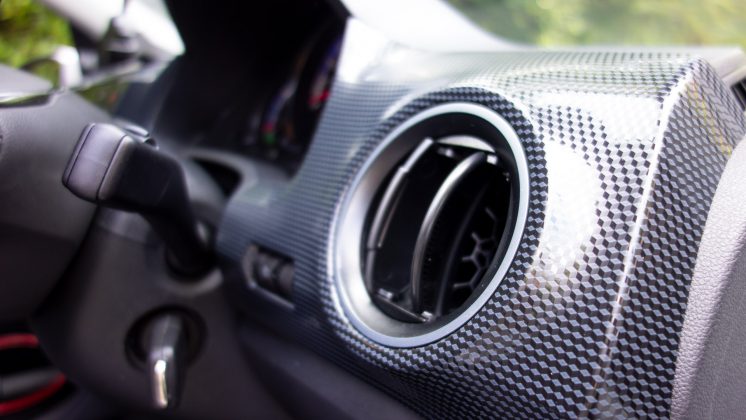
Read next: Audi A8 audio review: Is the Bang & Olufsen system worth it?
To us, however, the sense of simplicity works well. Volkswagen hasn’t complicated the vehicle’s ease-of-use. It’s all very functional and works well for the car’s target audience.
The e-up!’s six-speaker audio system, for example, can be summoned over Bluetooth (limited to the SBC codec, only). While the lack of a comprehensive infotainment system has led the German automaker to include a three-pronged smartphone holder that sits at the centre of the dashboard. The bundled accessory sits on top of a USB socket, which can provide your device with some power; it’s effectively aimed at replacing the associated infotainment display with the one on your smartphone. Volkswagen even has a ‘Maps + More’ app, which is specifically designed for the up! range to replicate a modern infotainment system on a smartphone.
1 of 3
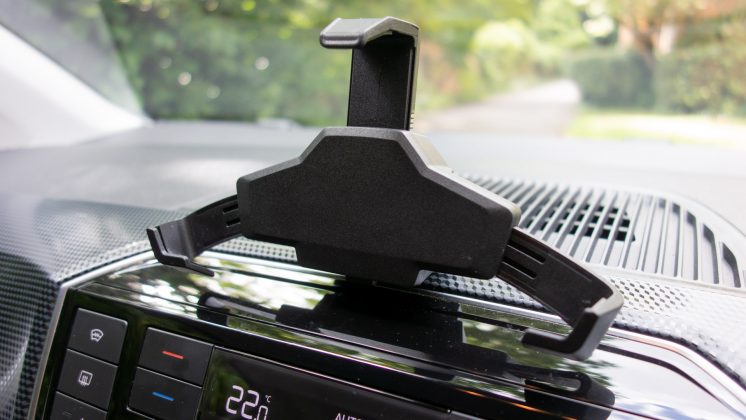
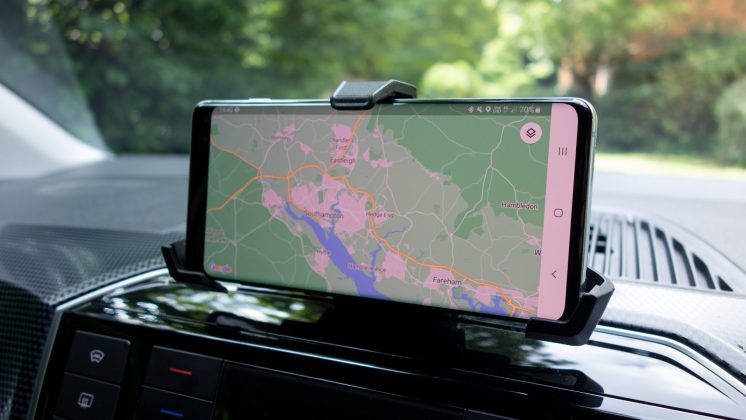
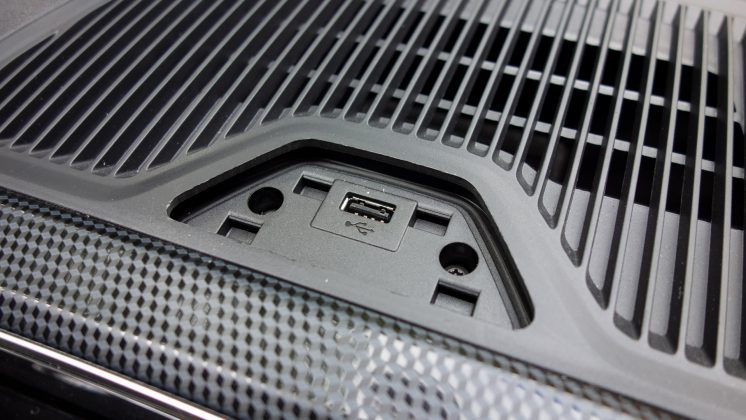
Under the phone holder, there are physical climate control buttons and a small LCD display that showcase the target temperature and fan speed.
As for the steering wheel, it’s appropriately laid out with media controls on the left and instrument cluster adjustments on the right. The cluster is presented in the form of three physical dials: one for power usage, another that serves as a battery-level indicator and finally, a larger third dial that’s used as a traditional speedometer. The latter has a small LCD display that can be customised to a certain degree.
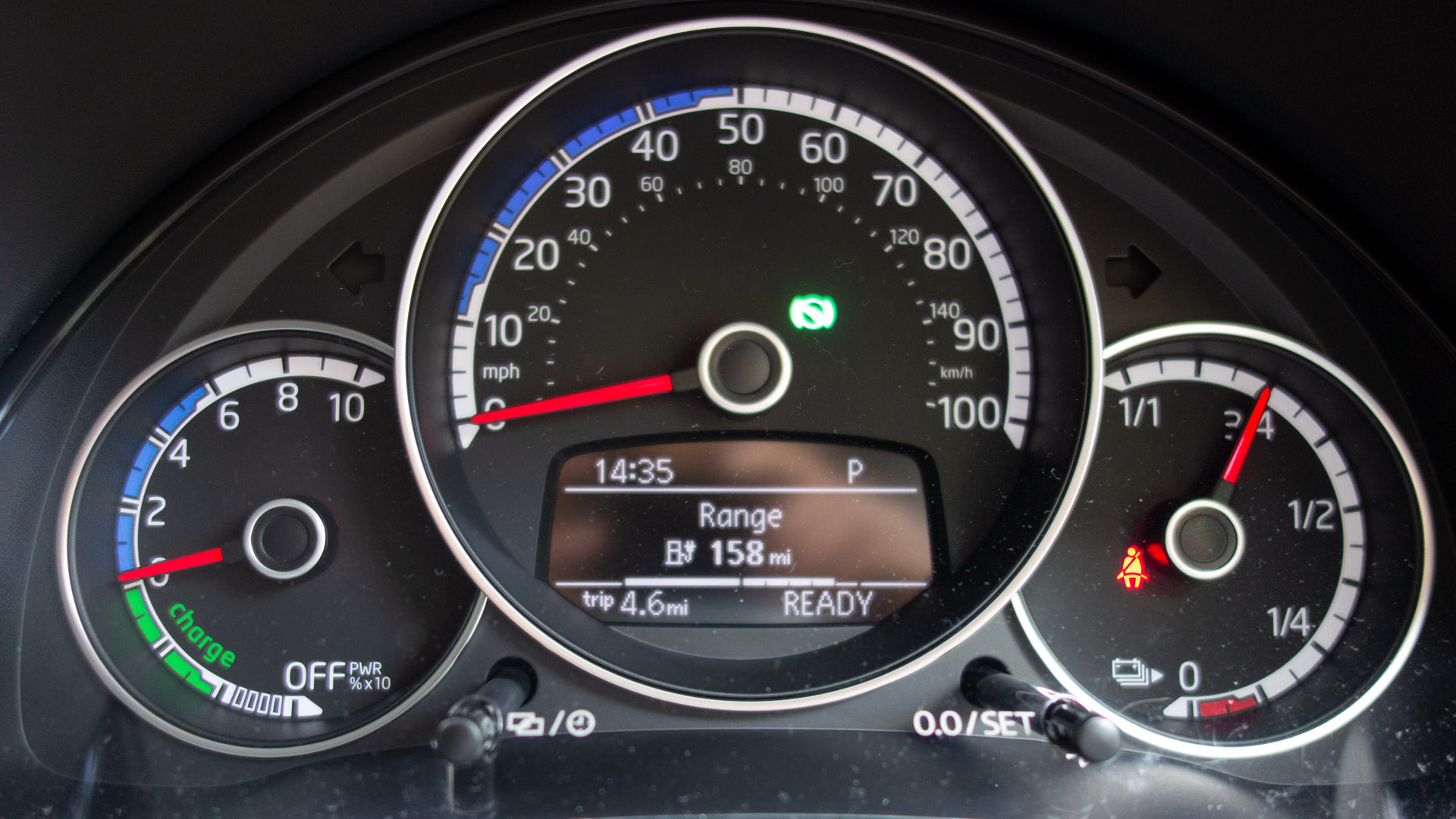
Move to the centre console and Volkswagen has even kept a physical handbrake, which is seemingly a rare occurrence nowadays in EVs. Here, you’ll also find a cup holder space, and further along, toward the gear selector a 12V socket and a small compartment to store your valuables and another 1-litre water bottle.
1 of 3
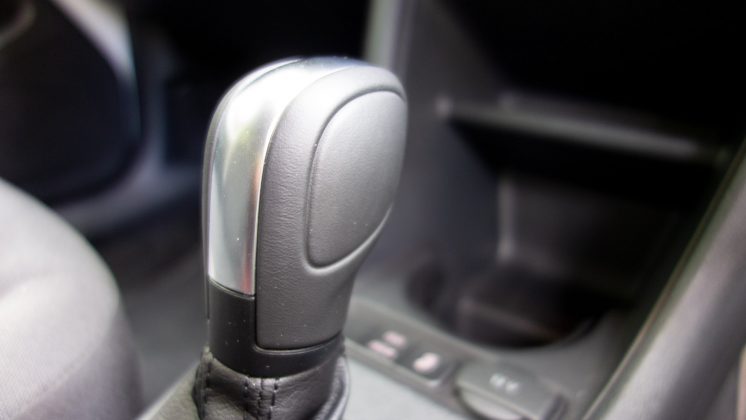
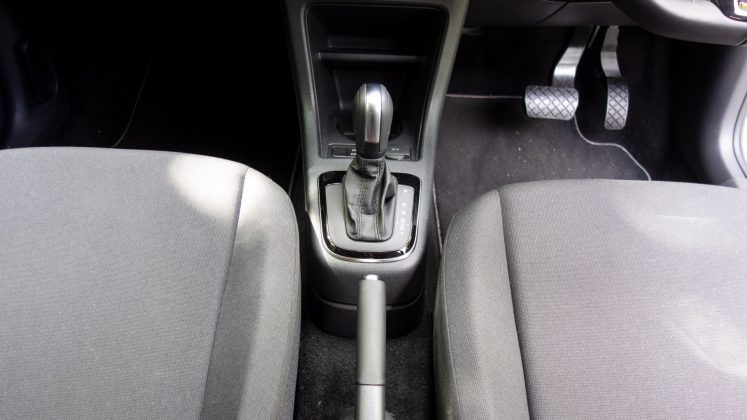
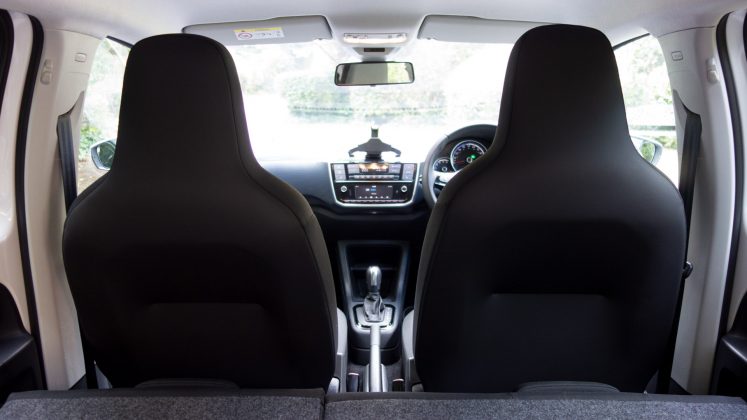
If you’d like to know how the stock 6-speaker system performs, watch our dedicated review of it on YouTube.
VW e-up! range & charging

The VW e-up! has been on sale for a number of years, but has recently received a significant upgrade with a larger capacity battery. It sees driving range almost double that of the previous version, yet pricing kept at similar levels. As such, EV buyers have a far more attractive proposition in the city car class.
There is one configuration available:
Range
Whilst the 159-mile range might seem too short for some buyers, it’s worth considering in context. Firstly, the WLTP range is almost double the 83-mile figure from the old battery pack. Secondly, it’s a WLTP figure, and so pretty accurate/achievable. And thirdly, the e-up! is a city car. As such, long distances are rarely covered, with only the occasional trip to see friends or family, or to go on holiday testing the outright range on a single charge. The e-up! is not aimed at regular motorway drivers, and should be judged accordingly.
In real-world driving, the e-up! performed extremely well in terms of driving range. It was easy to hit 145 miles on a charge, and that’s sticking largely to country roads with odd trips into a small town. This is not the ‘normal’ mileage for the e-up!, which would normally spend most of its time on urban routes and occasional runs on country roads or motorways. Sticking to town work, the e-up!’s range was closer to 200 miles on a charge.
Braking
Aiding range is the flexible brake energy recuperation system, with D/B modes as usual, plus four intermediate settings ranging from practically coasting to near one-pedal driving. It’s really useful, and although takes greater ‘work’ to make the most of, it can prove far more effective than a single B setting.
Charging
Charging will take around 40 minutes from a rapid DC point to 80%, and four and a half hours from a 7.2 kW AC unit, if you’re charging at home, for instance. The e-up! can charge at up to 7.2 kW AC and 40 kW DC, with a Type 2 CCS inlet on the rear off-side flank.
VW e-up! performance review
The car’s compact size does take its toll on usable storage space and comfort, but does make up its deficit in terms of drivability. The e-up! is a marvel on the road; it’s fun to drive, nippy and well-balanced when driven at speed on country roads. It’ll only get up to 81mph, however, but that’s more than enough for a city car.
When it comes to acceleration, the VW gets to 62mph in 11.9s. That’s not incredibly quick for an all-electric car, but given its small motor only outputs 60 kW (81hp) of power, it’s hardly surprising. Maximum torque is rated at 210 Nm.
1 of 3
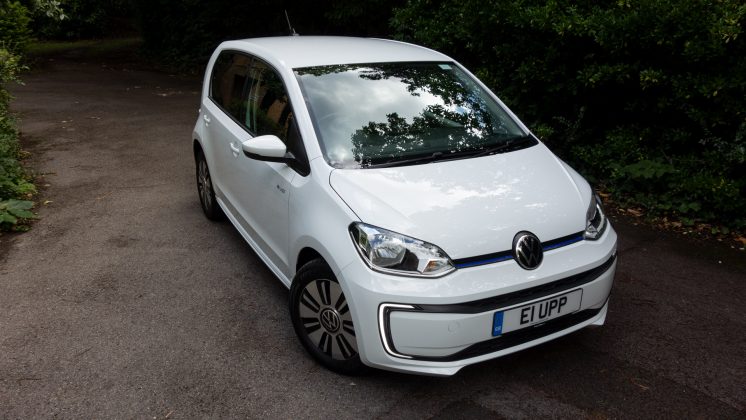
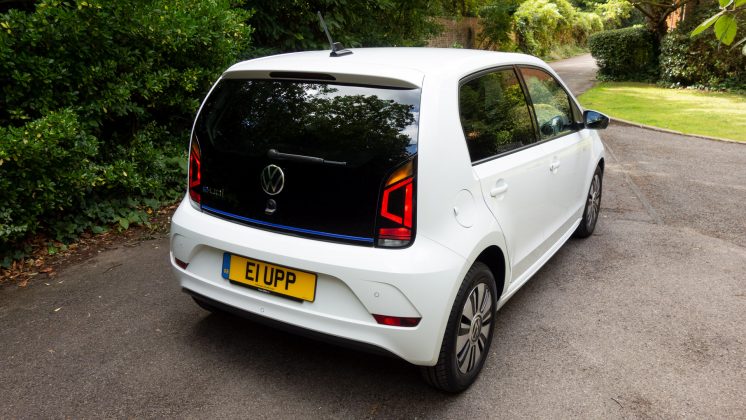
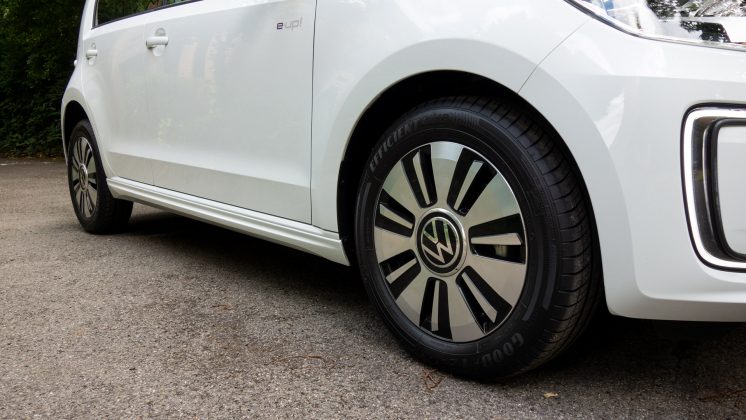
Raw performance aside, the car also makes light work of tight corners. Due to the e-up!’s small wheelbase, it’s supremely easy to manoeuvre. It’s aided by the fact that the steering wheel has a good size and feel to it, too; it’s not stiff nor feels disconnected with the front axles.
Similarly, when it comes to parking the large windows and glass boot make for great 360-degree visibility of the vehicle’s exterior. Pop the car in Reverse and the rear-view parking camera shows up on the small 5″ display on the dashboard. Here, you’ll also find the parking sensors come into play; making a tone when you get too close to an object.
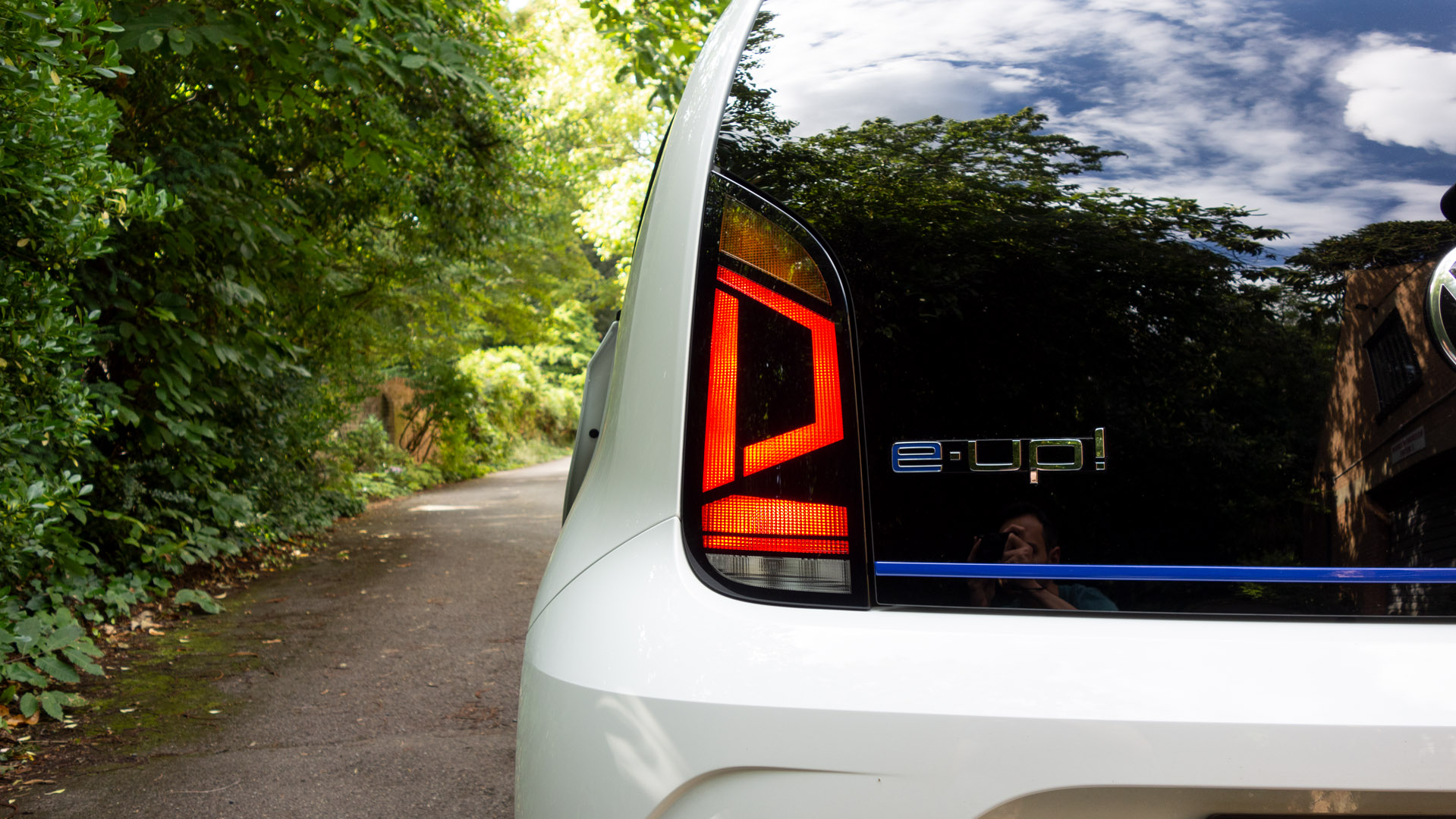
To shift between drive modes, you’ll need to use the gear selector positioned in the centre console. The familiar-looking knob, can be put in Park, Reverse, Neutral, Drive and B-Mode. The latter mode is to enable level 4 regenerative braking, whereby a one-pedal approach can be utilised within inner-city routes. If you find the pull back a bit too aggressive, level 1-3 can be accessed by shifting left (+) or right (-) when you’ve got the car in Drive.
The biggest bugbear is the car’s inability to store its last-selected drive mode. As such, each time you turn the key in the ignition, you’ll need to manually shift to a regenerative braking method, if you choose to use it, that is.
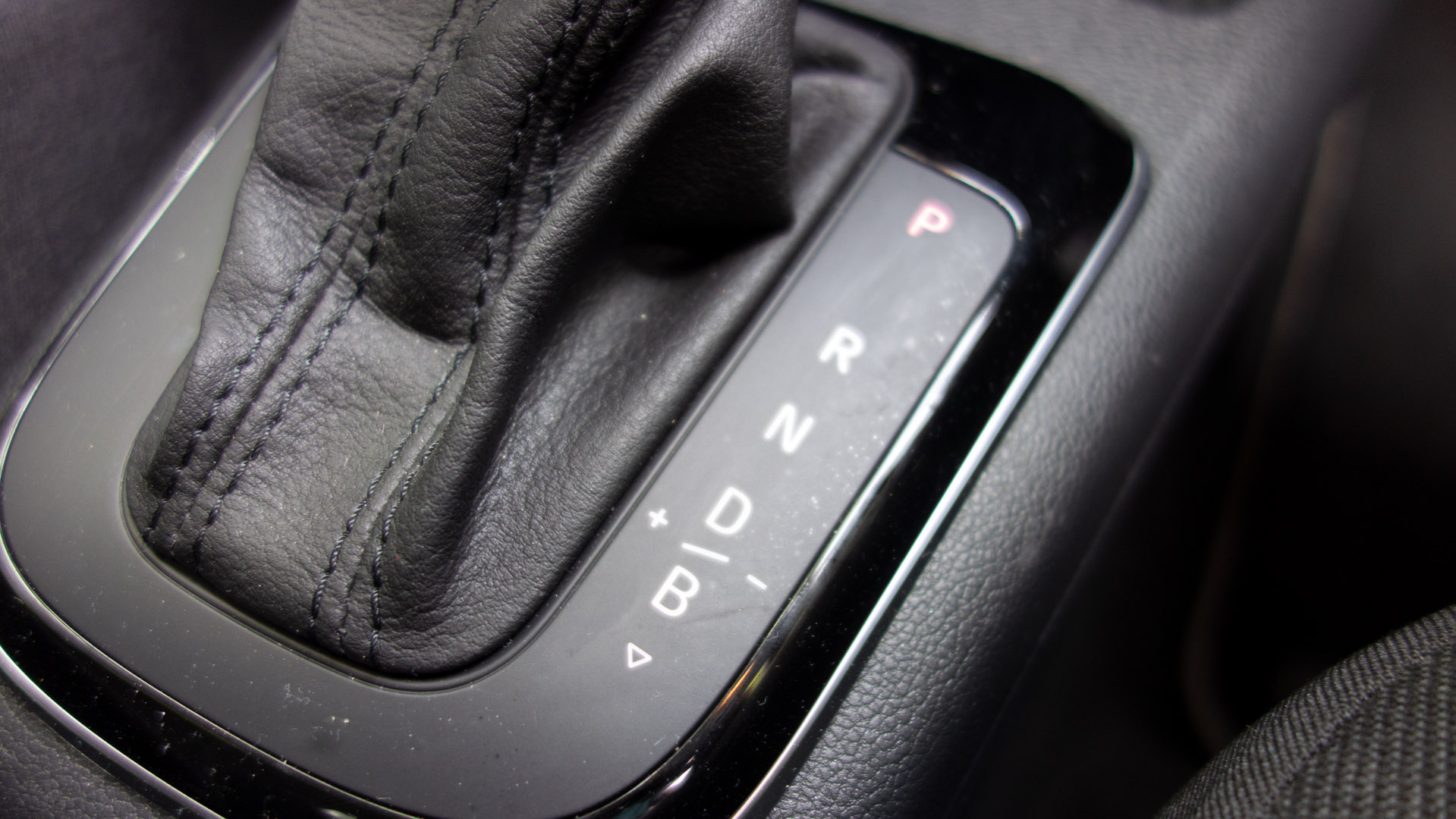
Read next: BMW X5 xDrive45e M Sport first drive: A 394hp plug-in hybrid SUV
Likewise, with Eco and Eco+ modes – the two drive modes that can be accessed by pressing the appropriately labelled button that resides by the gear selector – it needs to be pressed each time you enter the vehicle.
These two modes are aimed at prolonging the car’s driving range, with Eco limiting the car’s top speed to 70mph and its climate controls. Eco+ takes it a step further, where it disables climate controls altogether and limits max speed to 55mph – that is, if you don’t floor the accelerator.
When it comes to range, Volkwagen claims a 159-mile range. In our tests, however, this figure hovered around 120-140 miles in mixed driving conditions. Drive solely on the motorway, where electric vehicles don’t recoup any energy, and you’ll find the figure easily dips below 110 miles when averaging 70mph.
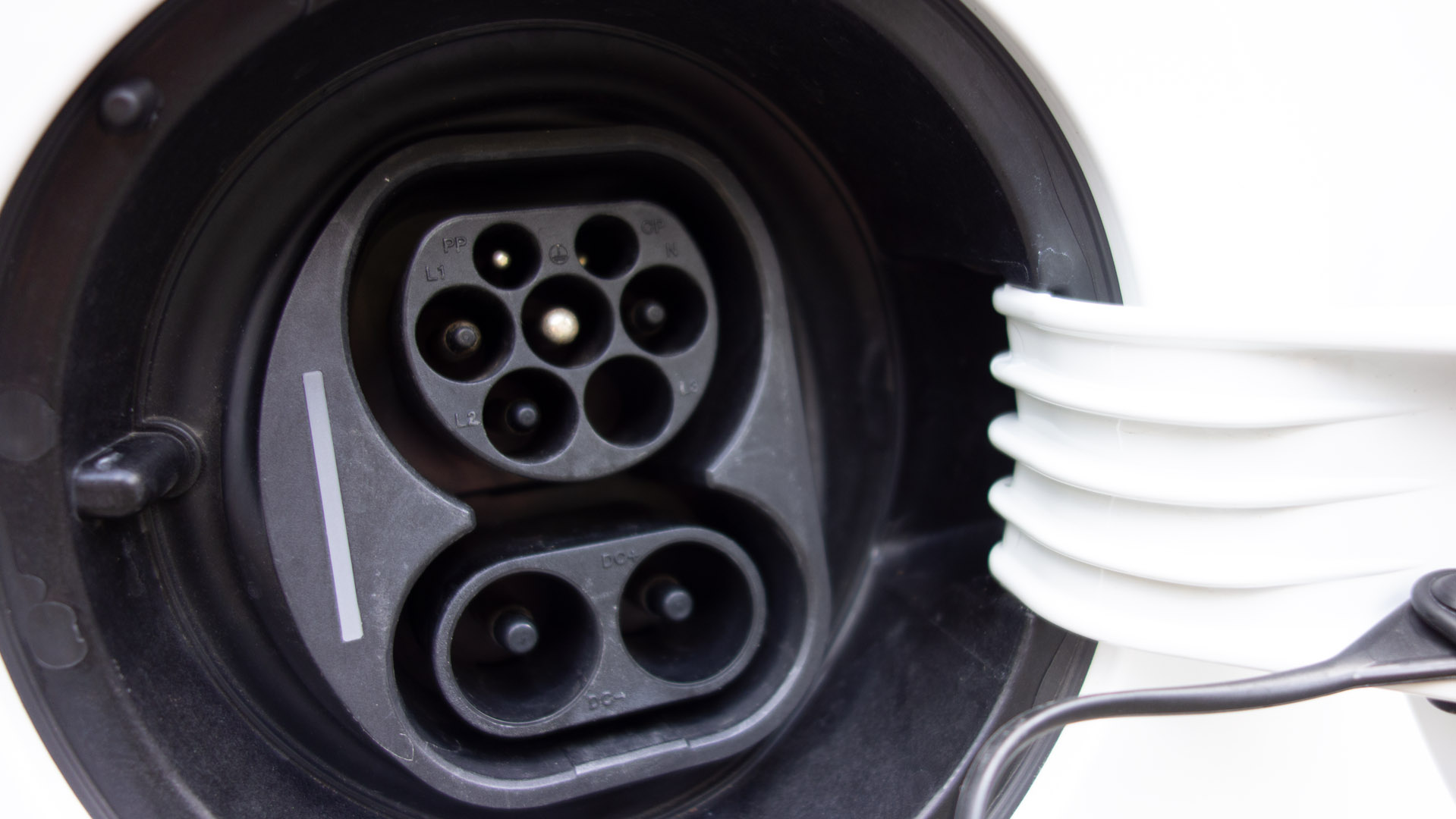
Driving on the motorway is aided by the addition of Cruise Control and Lane Assist, which make it easier for longer commutes. However, we wouldn’t expect those who frequently drive on the motorway to purchase the e-up!, as it’s ultimately a city car. Still, it’s a vast improvement over its first-generation model, which could only achieve, at most, 83 miles on a single charge; realistically it sat closer to 60 miles, instead.
To recharge the 32.3 kWh battery pack, you can make use of the 40 kW Combined Charging System (CCS) connector to charge an empty battery to 80% in just 60 minutes. Using a slower 7.2 kW Type 2 cable will equate to the same level of charge in about four hours.
Elsewhere, road noise is present from the car’s 165/65 R15 alloy wheels and wind noise can be heard deflecting off the vehicle’s A-pillars. It is noticeable when the car is driven on motorways, but is a non-issue when it’s faced with inner-city routes.
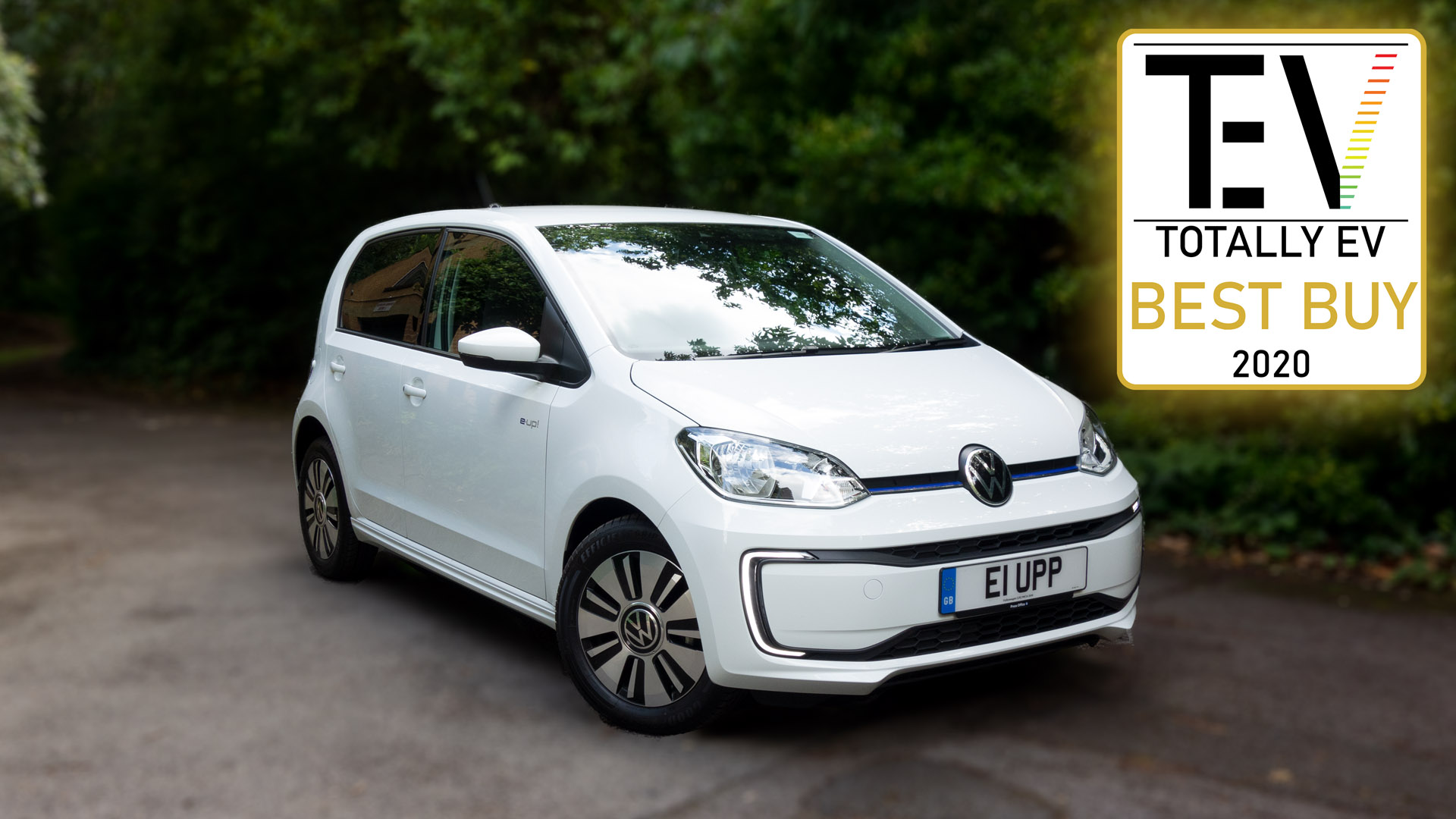
Read next: Mini Electric audio review: An impressive audio system
VW e-up! comfort review
At the rear, the seats are a little stiff and with the car limited to four seatbelts only, you can’t squeeze in a fifth adult or child in the middle seat. Instead, this space is reserved for additional storage space between the two rear passengers.
In terms of headroom and legroom, the rear of the cabin is compact; 6-foot (182cm) individuals will fit, but add a couple of inches and it’ll be severely uncomfortable to be seated at the back. It’s also not where you’ll want to be seated if it’s a long drive.
Thankfully, the front seats are a lot more comfortable and are manually adjustable, which with the added headroom means taller-sized individuals can drive or sit at the front.
It’s also worth knowing that at the rear, the windows are manually propped open, while at the front they’re electronically adjustable.
1 of 5
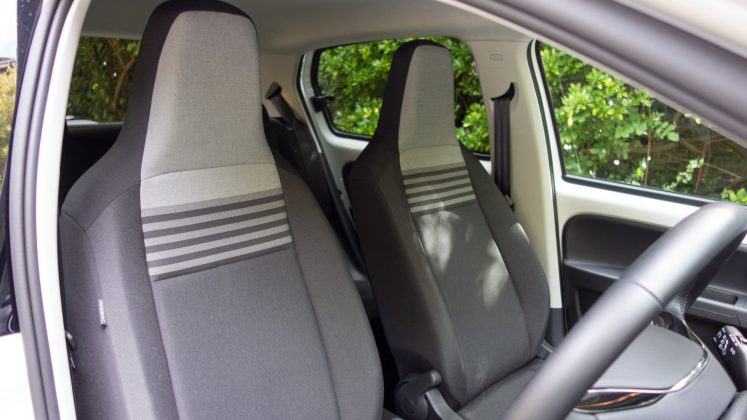
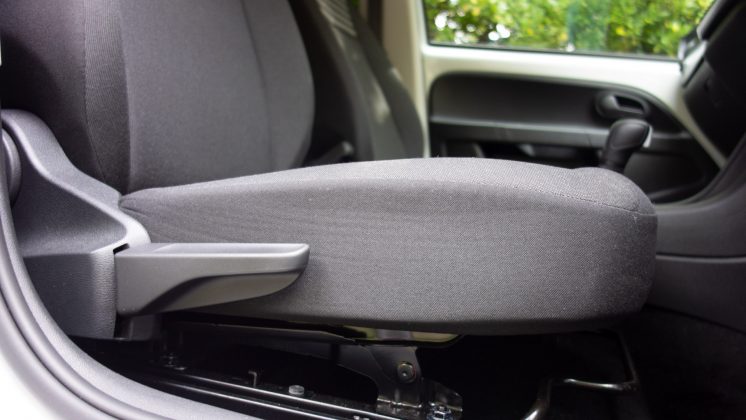
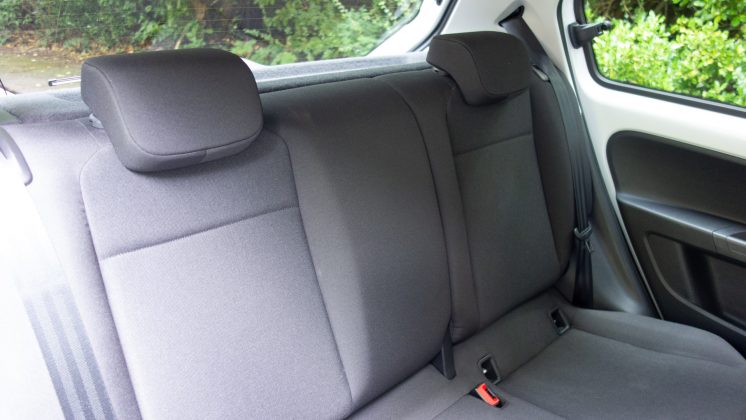
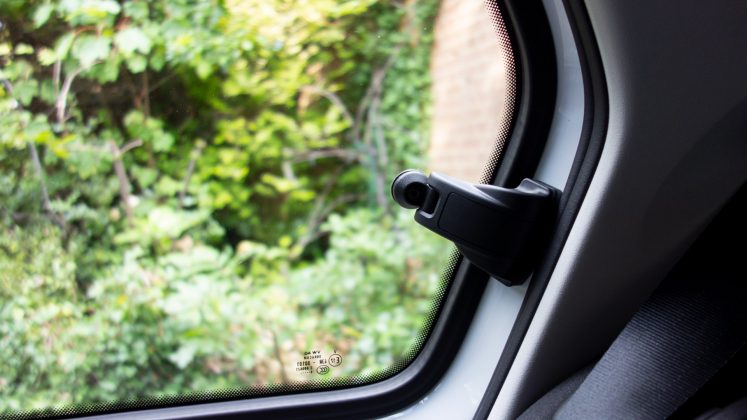
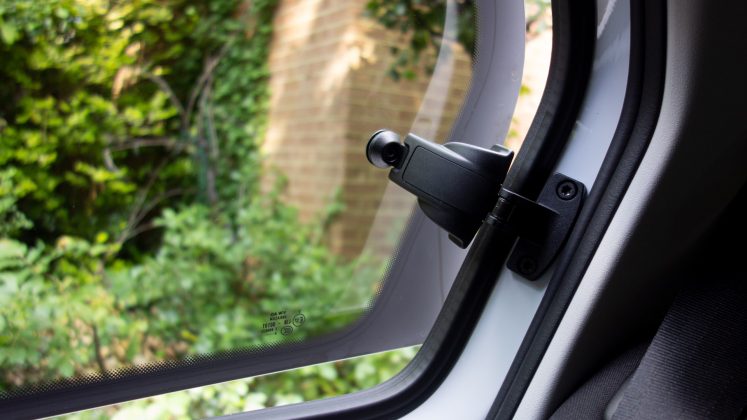
Read next: Extreme E: The electric off-road racing series
VW e-up! storage review
Due to its small size, the Volkswagen e-up! is limited to the amount of available storage space it has to offer; there’s just enough space to squeeze in a 500ml bottle in the front door compartments, while at the back, passengers will only have a small tray that resides within the doors, to place a small-sized smartphone.
In the boot, there’s 251 litres of usable storage space, which is enough to fit two hand luggage and a few garments. Prop the seats down to reveal 951 litres of space, and one can fit larger-sized luggage or, at a stretch, even a road bike.
1 of 7
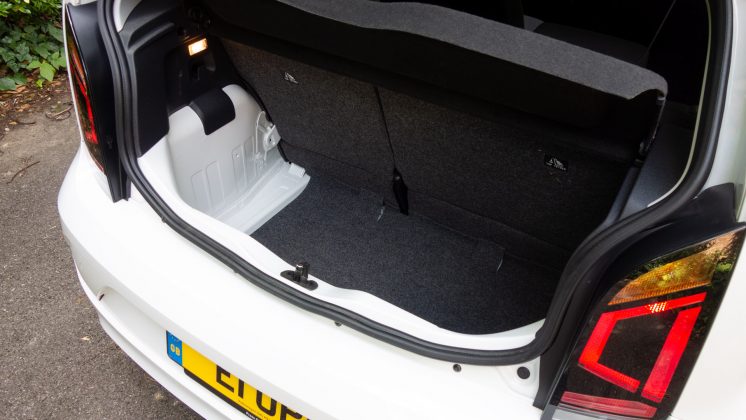
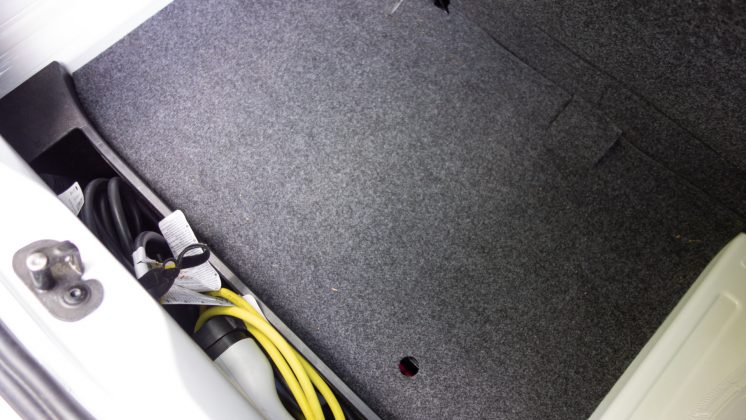
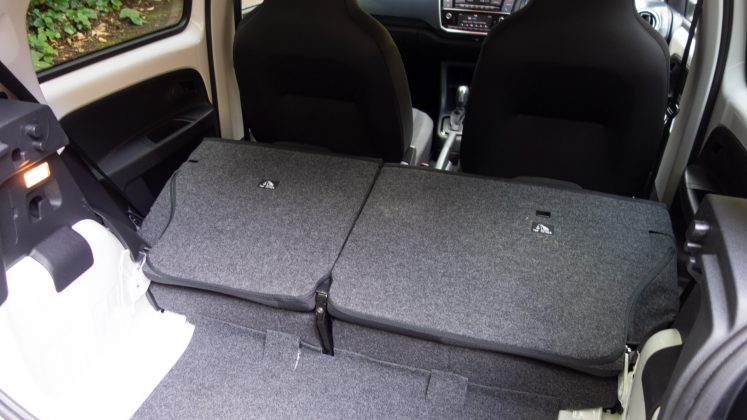
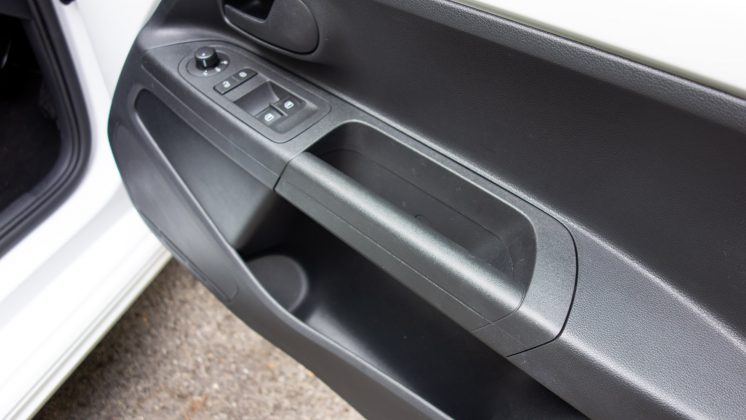
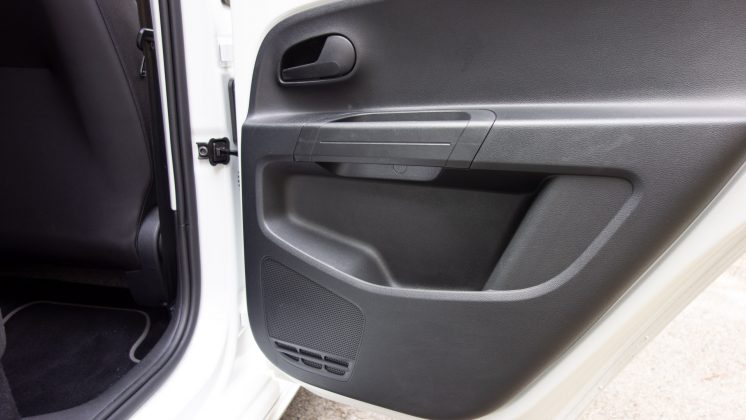
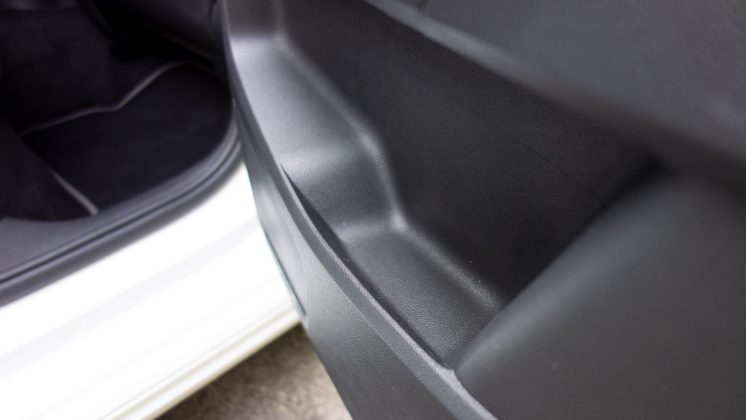
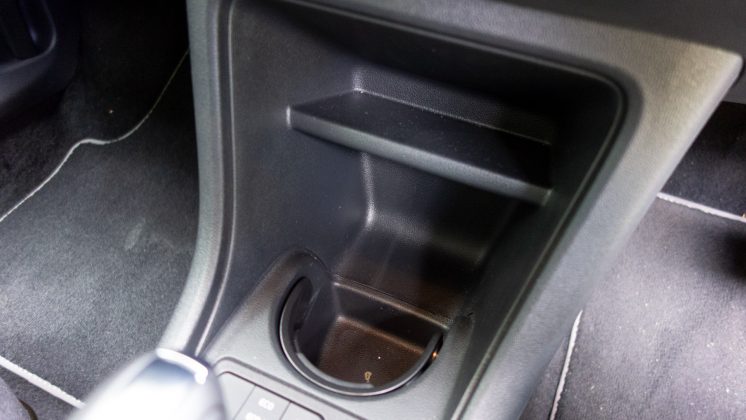
Read next: MG ZS EV Exclusive audio review: Impressive 3D surround sound
The VW e-up! on the road

Volkswagen’s e-up! is well designed for urban driving. Short overhangs, wheels pushed into the far corners of the car, and a low centre of gravity thanks in part to the battery being fitted in the floor means the e-up! has a surprising agility to its handling. The suspension is relatively pliant, but the VW can be thrown around tight corners and threaded along a narrow line as well as the best of them. It’s fun to drive when the mood takes and situation allows, but equally comfortable enough to deal with the rough surfaces frequently found in towns and cities.
What’s the VW e-up! like to drive?
The performance follows a very similar line to the handling set-up. Thanks to a light (for an EV) weight and compact dimensions, the e-up! offers punchy acceleration until around 50mph. The 0-62mph time of 11.9 seconds is sluggish, but the instant response and eagerness shown by the electric motor means that shorter dashes and ‘in-gear’ acceleration feels far quicker than the time suggests. It’s excellent around town, brilliant in car parks, enjoyable on country roads, and relatively refined on the motorway.
Charging a VW e-up! at home

Charging at home is often the most convenient and cost effective way to recharge an EV. Government grants are available for the installation of home EV charge points, and a large number of companies offer a fully installed charge point for a fixed price.
Most home chargers are either rated at 3 kW or 7 kW. The higher powered wall-mounted units normally cost more than the slower 3 kW option, but halve the time required to fully charge an EV. Many plug-in car manufacturers have deals or partnerships with charge point suppliers, and in some cases provide a free home charge point as part of a new car purchase.
Charging a VW e-up! on public networks

The UK has a large number of public EV charging networks, with some offering national coverage and others only found in a specific region. Major charging networks include bp pulse, GeniePoint, GRIDSERVE, InstaVolt, Osprey, Pod Point and ubitricity.
Payment and access methods across networks vary, with some networks providing an RFID card and others a smartphone app to use their services. While most require an account to be set up before use, some rapid units with contactless PAYG card readers are starting to be installed.
Although many EV charge points are free to use, the majority of fast and rapid chargers require payment. Charging tariffs tend to comprise a flat connection fee, a cost per charging time (pence per hour) and/or a cost per energy consumed (pence per kWh). For more information about network tariffs, visit Zap-Map’s public charge point networks guides.

VW e-up! tech & specifications

There’s one trim level for the e-up! so kit lists are simple. Fitted as standard are:
- ● 15-inch alloys
- ● Leather multi-function steering wheel
- ● Infotainment system with DAB, Bluetooth, USB and AUX connectivity
- ● Parking sensors front and rear
- ● Rear camera
- ● Climate control
- ● Cruise control
- ● Heated front seats
- ● Heated windscreen
- ● Automatic wipers & lights
Is the Volkswagen e-up! a good car?
The Volkswagen e-up! helps prove that electric power is not just a possibility in city cars, but often the best option. The e-up! has a range that will rarely be tested by urban drivers and those that are looking at city cars; and even if the trip is further than 150 miles or so, charging times are kept to a good level. It’s a practical, stylish and well equipped small car that has an excellent powertrain – it just happens to be electric.
All information above correct at time of publication. Official economy figures, pricing, and tax rates supplied by the manufacturer. Cost to charge based on 0-100% charge at home on a tariff of 16 p/kWh.
